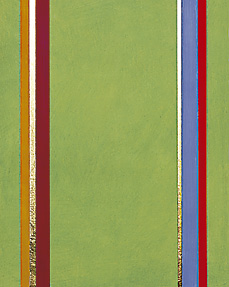|
Steffi Hartel’s
pictures are small and they all have the same format. All portray vertical
colored strips. Some have the same and some have different widths. Some
glow, some are mixed, some are at regular and some are at irregular distances
from each other. There are almost always one or two strips of gold leaf
between them. A series. The rows of strips following each other give the
impression that they could be either horizontally or vertically extended
beyond the edge of the picture and that the picture itself is just an
extract of this eternity. Different ambiances arise depending on the mixture
of colors—Norwegian, Maghreb, Rococo, New York; or even tones—major
and minor. What ideas and feelings can be caused by color? Hartel, who
was born in 1956, works in the tradition of American color-field painting,
which investigated the effects of color. Frank Stella, Gene Davis (1920–1985),
Daniel Buren and Bridget Riley painted strips of color, but each from
a different starting point. However, Hartel accentuates the perception
of color in a special way by using golden strips. Depending on the light
and the angle of perception of the viewer, they flash, protrude from the
surface of the picture, re-enter the rows of color when the viewer moves,
and turn green, red and yellow to function as colors themselves. Light
also paints—this is an aspect of Minimal art. The golden strips also
absorb the light radiation of the neighbouring colors. Because of this,
two golden strips can have different tones. The golden strips also react
to the spectator by incorporating his own colors (e.g. his sweater) into
the picture. In comparison to Michelangelo Pistoletto, who painted parts
of mirrors while leaving other parts unpainted, thereby making the spectator
and the surrounding space a part of the picture, Hartel’s interaction
is tranquil. Indeed, the golden strips give rise to associations of actual
space, while also referencing everyday reality at another level. The painters
of Siena around 1300 (Duccio, Simone Martini, Lorenzetti) used gold to
represent divine light in the background of the sacred legends. Those
who are enlightened wear a golden halo. Gold as divine light also symbolizes
preciousness and power. By using a gold frame which surrounds the painting
with an aureole, it is removed to the realms of the unapproachable. Finally,
gold also served the splendor of the Church and the secular authorities.
Such obvious ideas make Hartel’s pictures seem more distant and give
them something of the aura which once surrounded the divine. In spite
of the small format, her pictures have a concentrated effect. They are
celebratory and exquisitely colourful. The results of a long-planned experiment
are of a delicate beauty. Burkhard Brunn
|
